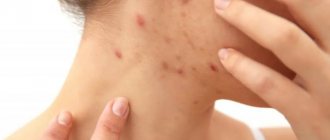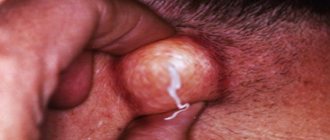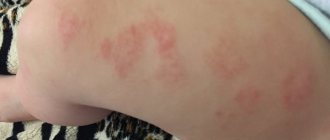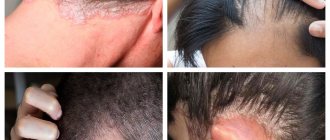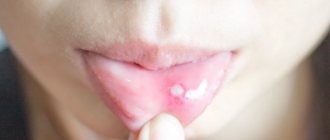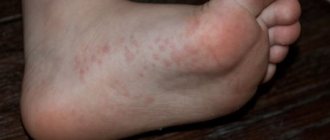Allergic rash similar to mosquito bites - what is it and how to fight it
From the article you will learn which allergies manifest themselves as rashes in the form of mosquito bites and other insects, as well as how to distinguish a mosquito bite from an allergy.
Mosquito bites, although not a pleasant event, are quite common in our lives. And during the period of activity of these insects, we do not pay much attention to the individual itchy blisters that appear on the skin every now and then.
But what if mosquito bites appear on the body, and it’s winter, when there are no mosquitoes nearby; fleas, ticks and other parasites capable of leaving such marks were also not found, and the rash in the form of mosquito bites still does not go away, persisting for several weeks, or even months.
In this case, first of all, suspicion falls on an allergy, namely on one of the varieties of its manifestation – urticaria.
The main reasons for the development of urticaria, or allergies in the form of mosquito bites, are allergies to insects, food products, medications, and infectious agents.
However, urticaria is a symptom not only of allergies, but also of autoimmune processes (an allergic reaction to the body’s own cells), toxicoderma (occurring when active and toxic chemical compounds get on the skin and into the body, from insect bites), disorders of the liver, as well as may occur when the skin is subjected to excessive physical exposure to cold, heat, sunlight, vibration, or pressure.
There are also other diseases whose symptoms are a similar rash:
- infectious diseases;
- diseases of the circulatory system;
- rubella, measles, herpes and some others.
Factors that can trigger rashes
There are many factors that can trigger the appearance of a red rash on a baby’s body.
Pimples appear most often due to the following reasons:
- Teeth are growing. Rashes that appear due to the eruption of a baby tooth are often localized in the area of the baby’s lips. The reason for this is that the baby produces a large amount of saliva. There is no need to treat such pimples; they will go away on their own after the teeth stop growing.
- Allergic reaction. Red rashes on a child’s body, small or larger, are sometimes evidence of an actively developing allergy. As a rule, an allergic reaction is accompanied, as an addition, by the following symptoms: runny nose and sneezing. During allergies, the baby may develop rashes all over the body, and they are often itchy. Therapeutic methods are prescribed by the doctor after the irritant has been identified.
- Prickly heat. When a baby wears clothes that are too warm, he sometimes develops pimples due to the fact that the skin sweats.
- Lack of hygiene. The rashes that appear if the skin is heavily contaminated are usually of a specific nature: they are inflamed and contain pus. Squeezing pimples in this situation is prohibited; you should seek help from a pediatrician, since such rashes sometimes cause infection. The best treatment option is careful adherence to hygiene rules.
- Weather. The reasons for the appearance of pimples on a baby's skin may lie in weather conditions such as frost, sun rays or wind. If you come into contact with such weather, you should take certain measures: wear warm clothes, use special creams against sun rays or windy weather, etc.
- Insects. Red, swollen pimples all over the body can appear due to the bites of various insects, including bedbugs and mosquitoes. Typically, such a rash itches and brings discomfort to the baby’s life. It is better to prevent such a rash from appearing, since the bite may cause an allergy or introduce parasites into the body.
There are many factors that provoke the appearance of a rash in childhood, and not all of them depend on the parents.
What do mosquito bites look like?
Most often, mosquito bites manifest themselves as itching and the formation of reddish blisters on the skin. Below in the photo gallery you can see what the body’s usual inflammatory reaction to a foreign insect protein looks like.
What does a mosquito bite look like in adults and children: photo
Main symptoms of mosquito bites
Sometimes it is possible to distinguish manifestations of an allergy from a bite without visiting a doctor.
| Symptom | Photo |
| Mosquitoes most often bite exposed areas of skin, so you are unlikely to find marks under clothing (especially thick ones) | |
| Visually, the bite is quite pronounced, with reddish inflammation around it. Often this area is quite itchy. | |
| You may notice multiple bites after sleeping (especially in the summer). The presence of marks on several family members also speaks in favor of bites. |
Prevention of dermatological pathologies: advice from doctors
If blisters form on the skin, you should seek help from a medical facility in the following situations:
- The blisters appeared for an unknown reason as a symptom of some disease;
- The formations arose in the child;
- The contents of pimples have purulent contents;
- The rash quickly spreads throughout the body;
- The rash is accompanied by unpleasant symptoms;
- The burn is large;
- The rash is accompanied by inflammation and swelling of the skin.
All types of skin rashes require consultation with a specialist; you should not self-medicate.
A dermatologist treats blisters on the skin. If the cause of the blisters is an allergy, the patient must be referred to a consultation with an allergist. For burns, you may need the help of a surgeon.
Allergy symptoms
Urticaria, or urticaria, is characteristic of an immediate allergic reaction, and therefore occurs within a few minutes after contact with the allergen.
Photo: characteristic appearance of allergic urticaria
The symptomatic manifestations of urticaria are similar to those caused by a nettle sting or an insect bite. It is due to the identity of the type of rash that allergies are similar to mosquito bites. Below are the main symptoms indicating an allergy.
- With this condition, blisters appear on the skin throughout the body - small, dense, swollen, raised elements of a round or irregular shape that can merge with each other. Please note that the rash in this case also occurs in areas covered by clothing
- The blisters are pale pink in color, and the surrounding skin is normal or reddened. The rash is accompanied by severe itching.
- Unlike a bite mark, which can remain unchanged for a long time, the rash disappears without a trace after the cessation of exposure to the allergen.
- The allergic reaction disappears quite quickly or becomes symptomatic when taking antihistamines
- People around you do not have any symptoms of the rash.
Actually, allergic reactions also occur to mosquito bites and other insects (especially in children) and there are few of them that can be confused with.
Familiarize yourself with the characteristics and treatment of this allergy, as well as photographs of allergic reactions to mosquitoes and other midges.
Allergy to insect bites
Manifests itself with hypertrophied symptoms of a local or general nature. Severe swelling may occur locally; the area of the body where there is a wound appears swollen, red, and enlarged. The general clinical picture is accompanied by:
- headache;
- dizziness;
- swelling of the throat and tongue;
- severe itching of the skin;
- convulsions;
- difficulty breathing;
- myocardial failure.
Treatment regimen:
- local hormonal creams, ointments;
- injection of glucocorticosteroids;
- antihistamines in tablets;
- infusion therapy (intravenous drip of saline, Ringer, etc.)
A red rash on the body may occur due to allergies. Often, allergic reactions become more active after eating new foods. Allergy pimples can be either small or large. They can be treated with folk remedies or pharmaceutical drugs.
Any treatment in this case will be useless until you identify the provoking allergen and exclude it from the diet (if it is a food product).
Treatment of allergic urticaria
The action of the allergen that caused the reaction ceases. In addition, the patient should switch to an elimination diet that excludes foods with a large number of allergens (chicken, citrus fruits, nuts, eggs, strawberries, spices, foods with a high content of dyes).
In acute cases of urticaria, antihistamines are prescribed.
In the case of the development of a severe form of the disease, infusion antihistamines, corticosteroids (prednisolone, dexamethasone), calcium preparations that reduce sensitivity to allergens (calcium chloride or gluconate) are used; when the allergen is taken orally, gastric lavage is performed, and activated carbon and other sorbents are also used.
Preventive measures
People who experience attacks of allergic urticaria are also prone to developing urticaria in response to other external factors: light, heat, cold, pressure, mechanical damage to the skin.
To ensure that allergies similar to mosquito bites bother you as little as possible, you should adhere to the following recommendations:
- Avoid stress; on the recommendation of a doctor, it is possible to take mild herbal-based sedatives.
- Avoid allergenic factors to which the patient is hypersensitive.
- Stop smoking and drinking alcohol.
- Be exposed to direct sunlight as little as possible (sunbathing is contraindicated). Also avoid prolonged exposure to high and low temperatures, use creams that protect from ultraviolet radiation and heat, and from cold.
- Take a shower, wash your face and wash your hands only with warm water, using soaps with skin-softening and moisturizing additives, and dry with soft towels.
- Do not take aspirin, codeine, ACE inhibitors.
- Do not use wardrobe items that put excessive pressure on the skin (tight clothing, belts, suspenders). Give preference to cotton clothes.
- Hypoallergenic diet, healthy eating.
- Treat diseases of the gastrointestinal tract and liver, infections in a timely manner.
- Maintaining a daily routine, alternating work and rest.
All this will prevent the occurrence of an attack of hives, which will make life much easier for allergy sufferers.
When does allergy in the form of mosquito bites occur?
Skin is one of the most sensitive anatomical structures of the human body. The appearance of an itchy rash on its surface, reminiscent of the consequences of contact with insects, suggests the presence of blisters. This is an element that does not have a cavity; it is swelling of the papillary layer of the connective tissue part of the skin. It is characterized by such symptoms as:
- existence for a short period of time (on average up to a day);
- combination with itching, burning;
- pink, in some cases – porcelain shade;
- round or irregular shape;
- tendency to merge.
The blisters disappear without transforming into secondary elements of the rash (cracks, erosions, ulcers, scars). Only in the case of intense scratching, scratches and wounds remain in the area of the affected areas - the consequences of active mechanical action, which heal within a few days and can serve as an “entry gate” for infection.
An allergy in the form of a mosquito bite is usually urticaria.
Before making a final diagnosis, other etiological (causal) factors not related to individual sensitivity, such as infection, must be considered. Some types of bacterial, viral, and fungal agents can cause redness, swelling, and rashes. In addition, insect bites (bugs, ticks) that were not noticed by the patient are quite likely.
Hives
Urticaria (Uriticaria) Sometimes also called nettle rash, urticaria is a dermatological condition characterized by pale red or white, raised, itchy rashes (blisters), each surrounded by a small red spot on the skin.
The condition of the skin is very similar to a nettle burn. According to Dermnetz.org, these blisters can be large, ranging in size from a few millimeters to several centimeters, making them look like swelling on the skin.
Hives are often associated with allergies, although there are many non-allergic causes. Allergic reactions promote the release of histamine and basophils, which then lead to damage to small blood vessels.
The rash may appear within minutes and go away within a few hours, and usually tends to change over time. The shape of the blisters varies from round and ring-shaped to uneven, reminiscent of a geographical map.
Although in most cases symptoms disappear in less than 24 hours, new blisters may appear as old ones clear up, sometimes migrating throughout the body.
Treatment
Hives are not a serious condition in most cases, and treatment is usually not required.
However, you can soothe the itching by taking an oral antihistamine, such as Zyrtec or Benadryl, or by applying calamine lotion. A cool bath may also help.
It is recommended to avoid exposure to any environmental elements or foods that may be a potential trigger for allergic reactions.
If this condition persists, you should consult your doctor. Steroid creams may need to be prescribed for a short period of time to reduce swelling. Antileukotriene therapy may also be prescribed to control histamine release.
Causes
Urticaria is a group of pathologies of an allergic nature, the basis of the pathogenesis (mechanism of development) of which is an immediate hypersensitivity reaction. The leading symptom is the presence of rapidly emerging and severely itchy blisters that disappear without a trace within up to 24 hours without secondary skin changes. There are several main reasons for the development of urticaria:
- Food products (citrus fruits, fish, nuts, peanuts).
- Medicines (antibiotics, vitamins, non-steroidal anti-inflammatory drugs).
- Insect bites (wasps, bees, hornets).
- Infectious agents (viruses, bacteria, fungi, helminths).
- Autoimmune pathologies (systemic lupus erythematosus, rheumatoid arthritis).
- Physical triggers (low and high temperature, vibration, sunlight, pressure, humidity).
Factors that contribute to the development of urticaria include:
- hereditary predisposition;
- diseases of the digestive tract, endocrine and nervous systems;
- infections and neoplasms.
Stress plays a part. It has been proven that nervous tension (including due to a change of place of residence, climatic conditions) affects the immune system and can lead to malfunctions in its functioning, which sometimes results in allergic sensitivity.
When and which doctor to contact
Experts say “that the earlier the diagnosis is made, the easier it is to cure the disease.” Therefore, if you experience small pimples that itch and swell, it is advisable to consult a doctor the next day.
This is a therapist or pediatrician, an allergist, a dermatologist. After passing the necessary tests, the healthcare professional will prescribe appropriate therapy.
Complications
If treatment is not started on time, a number of problems will arise that affect both appearance and future health. These are depressions, scars, increased pigmentation. Skin imperfections will remain for a long time, and maybe forever.
A person’s immunity will decrease, therefore, colds will be his constant companions. Complications from the disease can lead to malfunctions of internal organs, as well as death.
Symptoms in adults
Urticaria is classified as:
- acute (episodes of rash observed over a period of time lasting less than 6 weeks);
- chronic (repeated for more than 2 months);
- localized (rash occurs in separate areas of the skin);
- systemic (blisters cover the entire body).
Urticaria is a disease in which not only the skin is involved in the pathological process. There are likely additional signs that determine the severity of the sensitivity reaction.
Dermatological manifestations
The dominant group of symptoms, characterized by damage to the skin. Observed:
Blisters due to urticaria can be localized on absolutely any part of the body. Location on the scalp, palms and soles is not excluded. They itch very much.
If the rash occurs on the face, it practically does not rise above the skin level. The elements start out pink and soon become porcelain. This occurs due to compression of blood vessels as a result of increasing edema. Then, as the swelling decreases, the blisters turn red again and then disappear from the surface of the skin.
Quincke's edema
This form of reaction can be classified as a dermatological manifestation, but it is worth considering it separately. According to statistics, more than half of the episodes of urticaria are accompanied by angioedema; it is a dense swelling affecting the subcutaneous tissue. There is no intense itching. Changes can be localized in areas such as:
- face (lips, cheeks, eyelids, ears);
- external genitalia;
- oral cavity, nasopharynx;
- mucous membranes of the digestive and urinary organs.
The most dangerous is Quincke's edema in the larynx - it causes a narrowing of the airway and can lead to asphyxia (suffocation).
Additional manifestations
Allergies that look like mosquito bites can be characterized by the following symptoms:
- General weakness.
- Increased body temperature.
- Runny nose.
- Watery eyes, swelling of the eyelids.
- Pain in muscles and joints without specific localization.
Sometimes patients are bothered by a cough; symptoms of damage to the digestive tract are likely - lack of appetite, nausea and vomiting, as well as diarrhea in combination with flatulence and abdominal pain. These signs can be associated either directly with urticaria or with Quincke's edema.
An allergy sufferer may complain of fatigue, poor sleep, becomes irritable due to itching, and is unable to concentrate on everyday tasks.
Symptoms in children
Patients belonging to the younger age group often experience urticaria associated with food or drugs, as well as other triggers. Allergies in a child are characterized by the following symptoms:
- swelling and itching of the skin;
- the appearance of a rash in the form of blisters;
- increase in body temperature.
Fever can be observed even in infants and often causes misdiagnosis of infection, as it can reach high numbers. Children can suffer a systemic or generalized form of urticaria, which is combined with angioedema and is considered a life-threatening condition. But even with a mild reaction, the need to itch can lead to skin defects (wounds, ulcers) and infection.
Ringworm and its variety - eczema
When a child itches and becomes covered with red spots, it is quite logical to assume that he has lichen - a disease of a fungal or viral nature. You can become infected with it from animals (ringworm), as a result of damage to the skin or diseases of internal organs (eczema), after infection with a fungus (pityriasis versicolor), as a result of disturbances in the functioning of the immune system (lichen planus), as a result of infection by viruses (lichen rosea) .
Depending on the type of disease, it is characterized by different types of rashes:
pityriasis rosea is characterized by the appearance of small round pink or red spots; Pityriasis versicolor is characterized by darker red or even red-brown rashes; with ringworm, in addition to red spots, peeling and itching of the skin appears; eczema is characterized by the appearance of red spots, crusts, peeling, cracks, blisters; With lichen planus, shiny nodules of a reddish-purple hue of irregular shape are formed.
Despite the fact that lichen is treated mainly at home, it is impossible to do without medical help - only a doctor can confirm the diagnosis and determine the type of illness. Depending on the type of disease, antihistamines, corticosteroids and antifungals are used to treat it. It is also recommended to give up bad habits and adhere to a special diet.
To prevent the disease, it is important to strengthen the immune system and limit the baby’s contact with street animals.
Diagnostics
There are several main clinical criteria in favor of urticaria:
- Sudden onset of itching and blisters.
- The presence of a connection with the allergen (most often, contact with it occurs 30–60 minutes before signs of a reaction appear).
- The fleeting nature of the rash (that is, rapid disappearance without secondary elements).
In addition, anamnesis is important - information about past episodes of pathology, the presence of allergies (not necessarily urticaria) in close relatives. Additional methods are used to clarify the diagnosis.
Laboratory tests
May include different types of tests - from basic general clinical ones (determining the level of hemoglobin, red blood cells, counting leukocytes, examining urine and feces) to complex special ones:
- enzyme-linked immunosorbent assay (ELISA) to detect antibodies to reaction provocateurs - food products, insect venom, etc.;
- determination of markers of infections (in particular, viral hepatitis);
- serum tryptase level test;
- assessment of thyroid function indicators (hormonal panel).
It is also important to identify signs of helminthiasis, for which stool is examined for worm eggs and the use of ELISA to detect antibodies to parasites (giardia, opisthorchid, toxocara).
Skin tests
These are provocative tests to check for sensitivity. They involve applying a potential trigger to the forearm or back and waiting within a specific time period (minutes, hours).
For example, if the patient reacts to cold, a piece of ice in a moisture-proof wrapper is applied to the skin (to prevent contact with water, which can also cause urticaria). In case of intolerance to drugs or food, use special media that contain the suspected allergen. If signs of a reaction (redness, swelling, itching, blister) occur during the observation period, sensitivity is considered proven.
Treatment
Treatment for urticaria is carried out both at home and in a hospital department - it depends on the patient’s condition, the severity of symptoms and the presence of life-threatening signs. We must not forget that blisters on the skin can be a harbinger of anaphylactic shock - a reaction manifested by a sharp drop in blood pressure (collapse) and, like angioedema in the larynx, requiring emergency care.
Stopping contact with the trigger
It forms the basis of the treatment of any variant of urticaria and implies the absence of contact with the substance or physical factor that causes the reaction. Experts call this method elimination; it includes:
- Regular wet cleaning (elimination of dust and mites).
- Refusal to keep pets (relevant if you are sensitive to hair and secretions - saliva, urine).
- Excluding allergenic foods from the menu (in case of food intolerance).
- Selection of cosmetics that do not contain trigger components.
- Avoid using medications that cause reactions.
Elimination measures are observed throughout life. In children, sensitivity may disappear as they grow older, so control may be weakened - but only if you are sure that the immune system does not respond to contact with the provocateur.
Hypoallergenic diet
Must be strictly observed during the period of acute manifestations of the reaction (that is, when a rash or itching occurs); after the condition improves, the list of permitted products expands.
- bran bread;
- dull fruits and vegetables in heat-treated form;
- dryers, crackers;
- lean meat, fish;
- dairy products;
- cereals
Drinks allowed are still water, dyes, weak tea, and compote. You shouldn't eat:
- citrus;
- strawberries;
- chocolate;
- whole milk;
- mushrooms;
- red meat;
- canned food;
- tomatoes;
- radish;
- processed cheese;
- spicy seasonings.
You need to eat dishes prepared by boiling, stewing or baking in the oven. A great way is steam treatment. Excess sweets, semolina and legumes should be avoided. Oatmeal, offal (liver, kidneys) are limited.
Drug therapy
Various medications may be used to treat hives:
| Pharmacological group | Representatives | Destination purpose |
| Histamine H1 receptor blockers | Loratadine, Erius, Zyrtec, Fenistil | Rapid reduction of itching, swelling, elimination of rash. Therapy of Quincke's edema. |
| Glucocorticosteroids | Elokom, Prednisolone, Dexamethasone | |
| Adrenergic agonists | Adrenaline, Epinephrine | To provide emergency care for severe urticaria, laryngeal edema, anaphylactic shock |
| Mast cell membrane stabilizers | Ketotifen, Sodium cromoglycate | For long-term therapy with frequent relapses (repeated episodes) of urticaria. |
For children from 6 months old, you can use Zyrtec, Desloratadine, and if the child is younger, with the permission of the doctor, a short course of treatment with Dimetindene is allowed.
Prevention and useful tips
To avoid recurrence of urticaria, you must:
- Avoid contact with triggers.
- Stick to a hypoallergenic diet.
- Take a course of treatment.
People who are aware of a tendency to sensitivity reactions should carry antihistamine tablets (for example, Cetrin). You should choose drugs without a sedative (calming) effect - otherwise drowsiness and decreased ability to concentrate are possible.
If a child suffers from urticaria, you need to warn the adults around him about the diagnosis. These are older relatives (grandparents, etc.), a kindergarten teacher, a school teacher, and a teacher in a club or sports section. It is better if your son or daughter always has with him the medications recommended by the doctor to relieve the symptoms of urticaria, as well as a card indicating the diagnosis and the contact number of the family.
- Spring Fever: Let's Say Yes! healthy lifestyle
- Fitness from the cradle: introducing your child to a healthy lifestyle
- Healthy eating pyramid
- Cold allergy: what you need to know
- What you need to know about allergies
Healthy lifestyle © 2022 Attention! The information published on the site is for informational purposes only and does not constitute a recommendation for use. Be sure to consult with your doctor!
